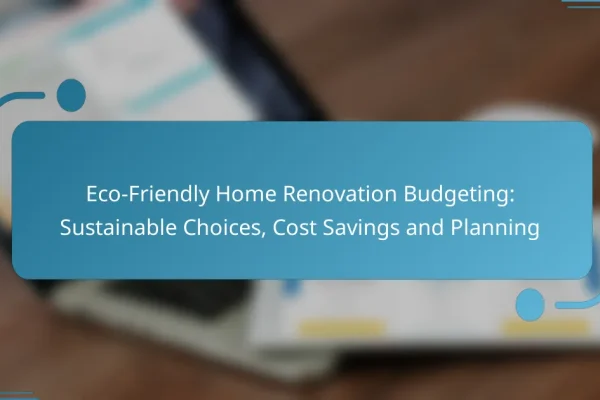How to create a home renovation budget in Los Angeles?
Creating a home renovation budget in Los Angeles involves assessing your project’s scope, estimating costs for materials and labor, and accounting for necessary permits. This approach ensures you allocate funds effectively and avoid unexpected expenses.
Identify project scope
Defining the project scope is the first step in budgeting for a renovation. Determine which areas of your home you want to renovate and the specific changes you wish to make, such as kitchen upgrades or bathroom remodels.
Consider the scale of your project. A minor update, like painting or replacing fixtures, will require a different budget compared to a major overhaul, such as adding a new room or changing the layout. Clearly outlining your goals helps in estimating costs accurately.
Estimate material costs
Material costs can vary widely based on quality and availability. Research prices for essential materials like flooring, cabinetry, and countertops to get a realistic estimate. In Los Angeles, you might expect to spend anywhere from a few thousand to tens of thousands of dollars depending on your choices.
Consider sourcing materials from local suppliers or larger home improvement stores, which often have competitive pricing. Keep an eye out for sales or discounts that can help reduce costs. It’s wise to include a buffer of about 10-20% in your budget for unexpected material price increases.
Include labor expenses
Labor costs can significantly impact your renovation budget. In Los Angeles, skilled labor rates can range from $50 to over $150 per hour, depending on the trade. Be sure to get multiple quotes from contractors to ensure you are getting a fair price.
When budgeting for labor, consider the complexity of the work. More intricate tasks, such as electrical or plumbing work, may require licensed professionals and thus higher costs. Always include a contingency for potential additional labor if unexpected issues arise during the renovation.
Account for permits and fees
Permits and fees are essential components of your renovation budget in Los Angeles. Depending on the scope of your project, you may need various permits, which can cost anywhere from a few hundred to several thousand dollars.
Check with the Los Angeles Department of Building and Safety for specific requirements related to your renovation. Failing to obtain necessary permits can lead to fines or delays, so it’s crucial to factor these costs into your overall budget early in the planning process.
What are common budgeting mistakes in home renovation?
Common budgeting mistakes in home renovation include underestimating costs, neglecting contingency funds, and ignoring hidden expenses. These errors can lead to financial strain and project delays, making it essential to plan carefully.
Underestimating costs
Many homeowners fail to accurately estimate the total costs of a renovation project. This often happens because they overlook various elements such as labor, materials, and permits. A good rule of thumb is to add 10-20% to your initial budget to cover unexpected expenses.
To avoid underestimating, gather multiple quotes from contractors and research material prices thoroughly. Create a detailed list of all anticipated expenses to ensure nothing is overlooked.
Neglecting contingency funds
Contingency funds are essential for any renovation budget, typically recommended at around 10-15% of the total project cost. These funds act as a financial buffer for unforeseen issues that may arise during construction, such as structural problems or code violations.
When planning your budget, set aside a specific amount for contingencies. This practice will help you manage unexpected costs without derailing your entire project.
Ignoring hidden expenses
Hidden expenses can significantly impact your renovation budget if not accounted for. These may include costs for inspections, disposal fees, or even temporary housing if the renovation makes your home uninhabitable.
To mitigate these risks, conduct thorough research and consult with professionals who can help identify potential hidden costs. Always include a line item in your budget for these expenses to avoid surprises later on.
How to prioritize renovations based on budget?
To prioritize renovations based on budget, start by identifying which projects will provide the most value for your investment. Focus on essential repairs and improvements that enhance functionality and appeal, ensuring your spending aligns with your financial goals.
Focus on high ROI projects
High return on investment (ROI) projects are those that significantly increase your home’s value relative to their cost. Common high ROI renovations include kitchen remodels, bathroom upgrades, and adding curb appeal through landscaping or exterior improvements. Aim for projects that typically yield returns of 70% to 90% or more, depending on your local market.
Before starting, research your neighborhood to understand which renovations are most valued by potential buyers. This can help you avoid spending on features that may not appeal to your target market.
Assess structural needs first
Addressing structural needs should be your top priority when budgeting for renovations. This includes fixing foundational issues, roof repairs, or plumbing and electrical upgrades. Ignoring these critical areas can lead to more significant problems and costs down the line.
Consider hiring a professional inspector to evaluate your home’s structural integrity. This investment can save you from unexpected expenses and ensure that your renovations are built on a solid foundation.
Consider energy efficiency upgrades
Energy efficiency upgrades can reduce utility bills and enhance comfort, making them a smart investment. Projects such as installing energy-efficient windows, upgrading insulation, or replacing old HVAC systems can yield savings that offset initial costs over time.
Look for local incentives or rebates that may be available for energy-efficient renovations. Many governments offer financial assistance to encourage homeowners to make these upgrades, which can further enhance your budget’s effectiveness.
What financing options are available for home renovations?
Homeowners have several financing options for renovations, including home equity loans, personal loans, and government grants. Each option has its own benefits and considerations that can impact your budget and project timeline.
Home equity loans
Home equity loans allow homeowners to borrow against the equity they have built in their property. Typically, these loans offer lower interest rates compared to personal loans, as they are secured by the home itself.
When considering a home equity loan, assess your current equity and the total amount you wish to borrow. Lenders usually allow you to borrow up to 80% of your home’s equity, but this can vary. Be mindful of closing costs and fees that may apply.
Personal loans
Personal loans are unsecured loans that can be used for home renovations without needing to leverage your home equity. They often come with higher interest rates than home equity loans, but they can be a good option for smaller projects.
When applying for a personal loan, check your credit score, as this will influence the interest rate you receive. Loan amounts typically range from a few thousand to tens of thousands of dollars, and repayment terms can vary from a few months to several years.
Government grants and programs
Government grants and programs can provide financial assistance for home renovations, particularly for low-income households or specific projects like energy efficiency upgrades. These funds do not need to be repaid, making them an attractive option.
Research local and federal programs that may be available in your area. For example, the U.S. Department of Housing and Urban Development (HUD) offers various grants, while some states have specific programs aimed at improving housing conditions. Always check eligibility requirements and application processes to maximize your chances of receiving assistance.
How to track renovation expenses effectively?
To track renovation expenses effectively, maintain a detailed record of all costs associated with your project. This includes materials, labor, permits, and unexpected expenses, allowing for better budget management and financial planning.
Use budgeting apps
Budgeting apps can simplify the process of tracking renovation expenses by providing a user-friendly interface to log and categorize costs. Many apps allow you to set budget limits, track spending in real-time, and generate reports to visualize your financial progress.
When choosing a budgeting app, consider features such as expense tracking, project management tools, and integration with bank accounts. Popular options include Mint, YNAB (You Need A Budget), and HomeZada, which cater specifically to home renovation projects.
To maximize the benefits of budgeting apps, regularly update your expenses and review your budget. This practice helps identify areas where you may overspend and allows for adjustments to keep your renovation on track financially.






